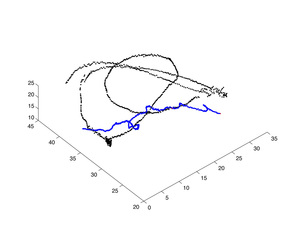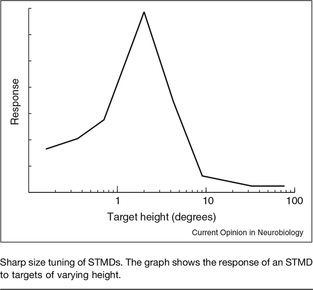In the Hoverfly Vision group we use hoverflies to understand how the nervous system codes visual information. We use a range of techniques, such as electrophysiology of single neurons in the fly brain and the descending nerve cord, quantitative behavior, free flight experiments, and field site measurements. Our naturalistic approach allows us to use behaviorally relevant stimuli in more controlled laboratory experiments.
Collaborators
We are starting a collaboration with Andy Barron to investigate how animal movements help make visual decisions. The project is funded by the Australian Research Council (ARC).
Together with Shannon Olsson at the National Centre for Biological Sciences we are investigating the combination of multisensory cues that are important for hoverflies when choosing which flowers to feed from. The project is primarily and generously funded by Stiftelsen Olle Engkvist Byggmästare, with additional support from Längmanska Kulturfonden and The Uppsala Botanic Garden.
We have been investigating target tracking mechanisms together with Paloma Gonzalez-Bellido at Minnesota University. The project was funded by the US Air Force Research Laboratory and the Australian Research Council (ARC).
Together with Shannon Olsson at the National Centre for Biological Sciences we are investigating the combination of multisensory cues that are important for hoverflies when choosing which flowers to feed from. The project is primarily and generously funded by Stiftelsen Olle Engkvist Byggmästare, with additional support from Längmanska Kulturfonden and The Uppsala Botanic Garden.
We have been investigating target tracking mechanisms together with Paloma Gonzalez-Bellido at Minnesota University. The project was funded by the US Air Force Research Laboratory and the Australian Research Council (ARC).
FUNDING
Our research is currently funded by the US Air Force Research Laboratory and The Australian Research Council and the Flinders Foundation.
Visual Coding of Natural Scene statistics
Animal sensory systems are optimally adapted to those features typically encountered in natural surrounds, thus allowing neurons that have a limited bandwidth to encode almost impossibly large input ranges. Importantly, natural scenes are not random, and peripheral visual systems have therefore evolved to reduce the predictable redundancy. The vertebrate visual cortex is also optimally tuned to the spatial statistics of natural scenes, but much less is known about how the insect brain responds to these.
We are redressing this deficiency using several techniques. Olga Dyakova uses exquisite image manipulation to give natural images unnatural image statistics, or vice versa. Marissa Holden then uses these images as stimuli in electrophysiological recordings of neurons in the fly optic lobes, to see how the brain codes for the statistics typically encountered in natural scenes, and Olga Dyakova measures the behavioral optomotor response on our trackball set-up.
Olga's first paper from this line of research was recently published in Nature Communications, with many more to come.
We are redressing this deficiency using several techniques. Olga Dyakova uses exquisite image manipulation to give natural images unnatural image statistics, or vice versa. Marissa Holden then uses these images as stimuli in electrophysiological recordings of neurons in the fly optic lobes, to see how the brain codes for the statistics typically encountered in natural scenes, and Olga Dyakova measures the behavioral optomotor response on our trackball set-up.
Olga's first paper from this line of research was recently published in Nature Communications, with many more to come.
Target Tracking: Neural and behavioral mechanisms
|
Hoverfly behavior has been remarkably understudied since the pioneering work in the 1970's by Mike Land and Tom Collett. To mitigate this deficiency we have several behavior projects lined up. Malin Thyselius has developed a free flight arena, which is big and bright enough for hoverflies to display conspecific interactions. By filming the flies with two cameras we can reconstruct their 3D flight trajectories. The top figure on the left shows the trajectories of two male hoverflies chasing each other.
Insects that pursue targets often do so in highly textured surrounds. During pursuit the target thus has to be visualized against self-generated optic flow. It is not computationally trivial to detect targets, since features in the surround may generate similar retinal signatures. For example, a leaf swaying back and forth in the wind may locally generate independent motion from the remaining background, but should be behaviorally ignored during pursuits of prey or conspecifics. Despite the challenging task, insects generate appropriate behavioral responses to visual stimuli within tens of milliseconds, much faster than the response of a human sprinter to the sound of a starter pistol. Malin Thyselius is currently filming hoverflies displaying conspecific interactions in the field. She is also using the indoor arena to quantify target tracking behaviors in more controlled settings. Simultaneously, we are recording from target neurons in the insect nervous system to understand how they encode behaviorally relevant stimuli. The project is funded by AFOSR and is performed in collaboration with Paloma Gonzelez-Bellido and Trevor Wardill in Cambridge. Our collaboration has already generated exciting papers. |
What makes hoverflies visit some flowers and not others?
The world’s bee and bumblebee populations are declining, though an estimated 80% of European crops are directly dependent on insects for pollination. Preserving and promoting wild pollinators is therefore crucial for sustainable agriculture. In addition to maintaining natural habitats and reducing pesticide use, an increased understanding of why and how wild pollinators utilize certain sources will allow us to propose efficient planting and maintenance strategies that maximize crop pollination. Hoverflies are ecologically important alternative pollinators and provide an extremely valuable alternative to the world’s wavering bee populations.
Together with Shannon Olsson at the National Centre for Biological Sciences in Bangalore we utilize a multimodal and multivariate approach to determine the cues that attract hoverflies to specific flowers. We have a unique ability to measure multimodal parameters on a very local scale. Our data suggests that a combination of visual, chemical, and abiotic cues create an optimal hoverfly signature for increased attraction to certain sites. After quantitatively characterizing this signature in several sites, we tested our hypotheses using artificial lures, which really did attract hoverflies! Our first findings were published in PNAS.
The project is funded by Stiftelsen Olle Engkvist Byggmästare.
Together with Shannon Olsson at the National Centre for Biological Sciences in Bangalore we utilize a multimodal and multivariate approach to determine the cues that attract hoverflies to specific flowers. We have a unique ability to measure multimodal parameters on a very local scale. Our data suggests that a combination of visual, chemical, and abiotic cues create an optimal hoverfly signature for increased attraction to certain sites. After quantitatively characterizing this signature in several sites, we tested our hypotheses using artificial lures, which really did attract hoverflies! Our first findings were published in PNAS.
The project is funded by Stiftelsen Olle Engkvist Byggmästare.



